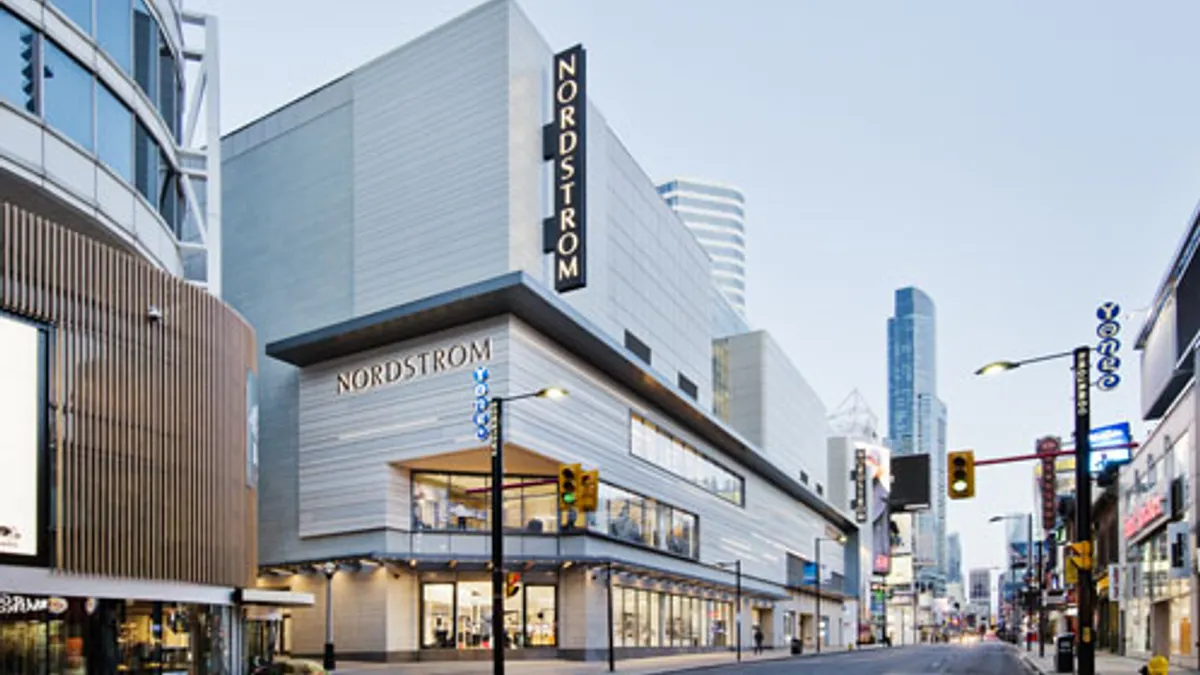Dive Brief:
-
Nordstrom is winding down its business in Canada, which provides less than 3% of its sales, because profitability has remained elusive since it was established in 2014. Six full-line Nordstrom stores, seven Rack stores and the Canadian website are closing, affecting about 2,500 employees, according to a press release Thursday.
-
The announcement came as the department store reported that Q4 net sales fell 4.1% year over year to $4.2 billion, with Nordstrom down 2.4% and off-price Rack down 8.1%. Digital sales fell 13.1%.
-
Gross profit, as a percentage of net sales, contracted by 525 basis points to 33.2%, mostly due to higher markdowns as Nordstrom prioritized right-sizing inventory; ending inventory was down 15.2%. Net earnings tumbled 40.5% to $119 million.
Dive Insight:
While the off-price segment has been flourishing lately, as high-quality merchandise flows in and consumers search out deals, Nordstrom’s Rack continues to falter.
“The current environment is also one which is very favorable to the value focused off-price segment and other operators are picking up customers,” GlobalData Managing Director Neil Saunders said in emailed comments. “As such, there are no external excuses for this abysmal performance and Nordstrom must shoulder all the blame.”
Part of Rack’s most recent declines is due to the company’s decision to end its policy of fulfilling online orders from stores. But improving that business is a top way to get the whole company on a better trajectory, CEO Erik Nordstrom told analysts Thursday.
“We are committed to improving both our top- and bottom-line performance at Nordstrom Rack in three ways,” he said. Those entail “prioritizing 100 nationally recognized strategic brands to help us drive sales and grow market share,” expanding the footprint with 20 new stores this year and improving online sales, he said.
He pushed back on the notion that it could be more prudent to wait on the brick-and-mortar expansion in light of executives’ observation that consumers, especially the lower-income ones who gravitate toward Rack, are pulling back on discretionary spending,
“First and foremost, our Rack stores are a great return on investment, full stop,” he said, noting that the company has a strong record of return on those stores. “It is a great use of capital. It's a low-capital investment, low-risk investment on a proven model.”
Rack stores provide 40% of the company’s customer acquisition while the cumulative investment in them will take less than 15% of its total capital expenditure plan for the year, executives said. And there’s room to grow considering that competitors run many more locations.
“So there's just a lot of goodness all around for us, opening Rack stores,” Erik Nordstrom said.
The three newest Rack stores are beating the company’s expectations and outperforming the fleet average in sales productivity and EBIT margin, according to Erik Nordstrom. But one of them, in Arizona, “has severe issues with lack of inventory and an imbalance in the type of products being offered,” GlobalData’s Saunders said. “Sadly, management has not only failed to address this but has also been reluctant to admit there is any kind of problem.”
The effort to prioritize 100 brands could also end up being a stumbling block because it flies in the face of one of the best merchandising upsides in the sector, which is the ability to take advantage of excess inventory in the market, according to BMO Capital Markets Managing Director Simeon Siegel.
“This is slightly confusing to us as the nature of Off Price is to not be able to forecast and plan brands in the same way as the full price channel, recognizing that when done right, Off Price retailers are more subject to the brands’ availabilities, which makes us wonder how the company is planning their brand availability rather than being at the whim of full price ‘mistakes,’” he said in emailed comments. “This further raises questions about how ‘Off Price’ Rack is.”














